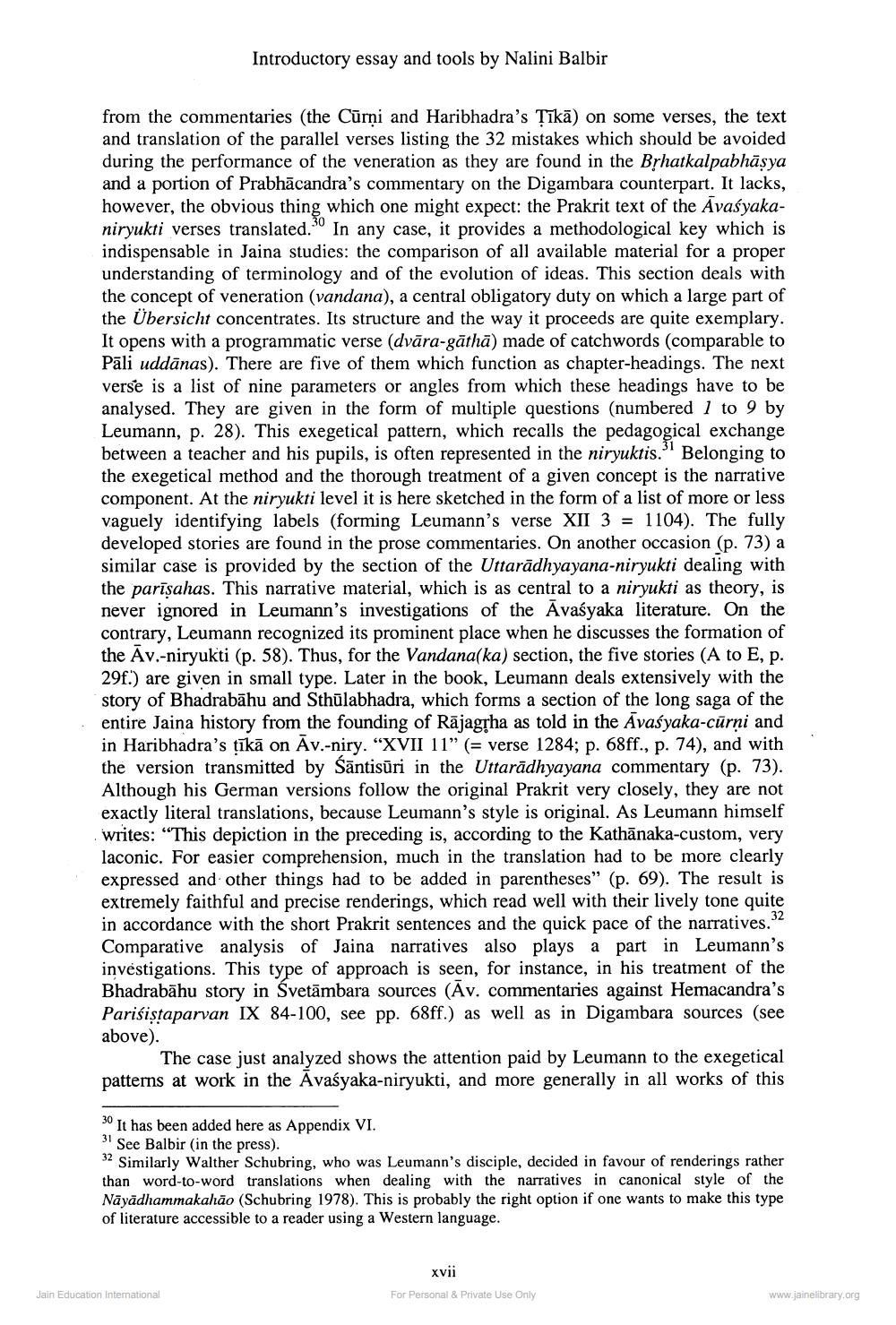________________
Introductory essay and tools by Nalini Balbir
from the commentaries (the Cūrņi and Haribhadra's Tīkā) on some verses, the text and translation of the parallel verses listing the 32 mistakes which should be avoided during the performance of the veneration as they are found in the Brhatkalpabhāsya and a portion of Prabhācandra's commentary on the Digambara counterpart. It lacks, however, the obvious thing which one might expect: the Prakrit text of the Avasyakaniryukti verses translated." In any case, it provides a methodological key which is indispensable in Jaina studies: the comparison of all available material for a proper understanding of terminology and of the evolution of ideas. This section deals with the concept of veneration (vandana), a central obligatory duty on which a large part of the Übersicht concentrates. Its structure and the way it proceeds are quite exemplary. It opens with a programmatic verse (dvāra-gāthā) made of catchwords (comparable to Pāli uddānas). There are five of them which function as chapter-headings. The next verse is a list of nine parameters or angles from which these headings have to be analysed. They are given in the form of multiple questions (numbered 1 to 9 by Leumann, p. 28). This exegetical pattern, which recalls the pedagogical exchange between a teacher and his pupils, is often represented in the niryuktis." Belonging to the exegetical method and the thorough treatment of a given concept is the narrative component. At the niryukti level it is here sketched in the form of a list of more or less vaguely identifying labels (forming Leumann's verse XII 3 = 1104). The fully developed stories are found in the prose commentaries. On another occasion (p. 73) a similar case is provided by the section of the Uttarādhyayana-niryukti dealing with the parīsahas. This narrative material, which is as central to a niryukti as theory, is never ignored in Leumann's investigations of the Avaśyaka literature. On the contrary, Leumann recognized its prominent place when he discusses the formation of the Āv.-niryukti (p. 58). Thus, for the Vandana(ka) section, the five stories (A to E, p. 29f.) are given in small type. Later in the book, Leumann deals extensively with the story of Bhadrabāhu and Sthūlabhadra, which forms a section of the long saga of the entire Jaina history from the founding of Rājagrha as told in the Avasyaka-cūrni and in Haribhadra's tīkā on Āv.-niry. "XVII 11" (= verse 1284; p. 68ff., p. 74), and with the version transmitted by sāntisūri in the Uttarādhyayana commentary (p. 73). Although his German versions follow the original Prakrit very closely, they are not exactly literal translations, because Leumann's style is original. As Leumann himself writes: "This depiction in the preceding is, according to the Kathānaka-custom, very laconic. For easier comprehension, much in the translation had to be more clearly expressed and other things had to be added in parentheses” (p. 69). The result is extremely faithful and precise renderings, which read well with their lively tone quite in accordance with the short Prakrit sentences and the quick pace of the narratives." Comparative analysis of Jaina narratives also plays a part in Leumann's investigations. This type of approach is seen, for instance, in his treatment of the Bhadrabāhu story in Svetambara sources (Āv. commentaries against Hemacandra's Parisistaparvan IX 84-100, see pp. 68ff.) as well as in Digambara sources (see above).
The case just analyzed shows the attention paid by Leumann to the exegetical patterns at work in the Avaśyaka-niryukti, and more generally in all works of this
30 It has been added here as Appendix VI. 31 See Balbir (in the press). 32 Similarly Walther Schubring, who was Leumann's disciple, decided in favour of renderings rather than word-to-word translations when dealing with the narratives in canonical style of the Nāyādhammakahāo (Schubring 1978). This is probably the right option if one wants to make this type of literature accessible to a reader using a Western language.
xvii For Personal & Private Use Only
Jain Education International
www.jainelibrary.org




